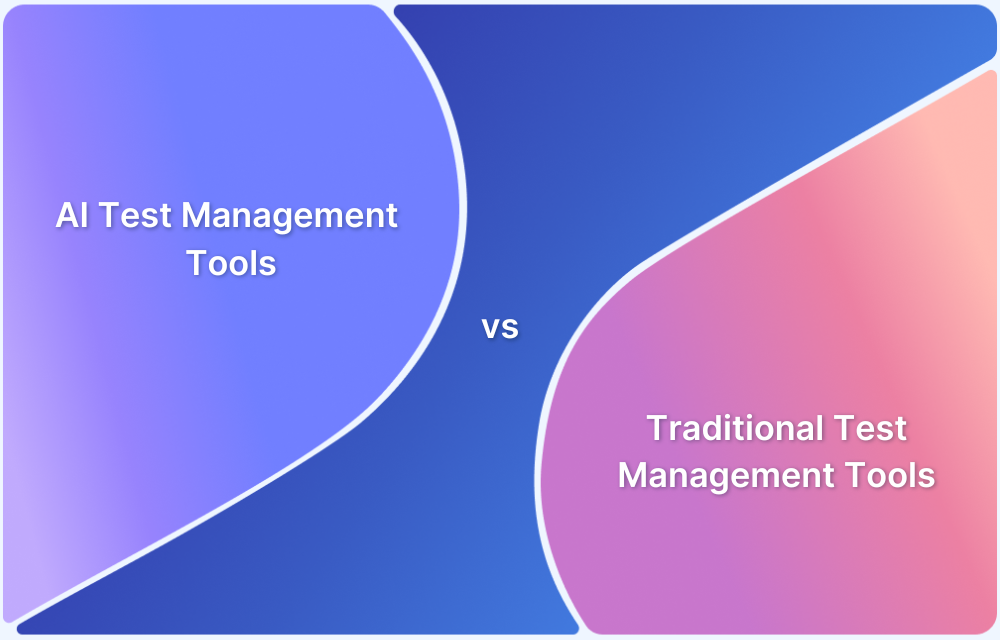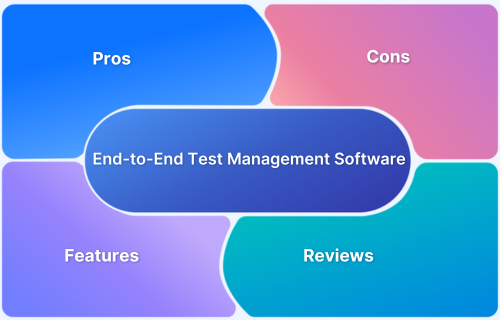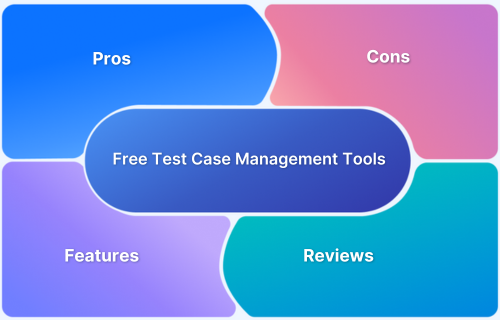Cloud-based test management software has become essential for modern QA teams aiming for faster, more efficient, and collaborative testing. With the rise of remote work and complex software ecosystems, cloud-driven platforms help teams manage, execute, and track test cases in real time from anywhere.
Overview
Top Cloud-Based Test Management Software [2025]:
- BrowserStack Test Management: AI-powered platform streamlining test authoring, execution, analytics, and integrations for both manual and automated testing.
- TestRail: Milestone-based planning with robust reporting, flexible manual/automated test runs, and direct Jira integration for large team scalability.
- PractiTest: End-to-end traceability with customizable dashboards and API/third-party integrations for Agile and hybrid QA workflows.
- aqua Cloud: AI-driven enterprise QA, centralized management, automation integration, and modular test assets for high-complexity environments.
- Zephyr Scale / Zephyr Enterprise: Native Jira traceability, BDD/Gherkin support, test versioning, and cross-project sharing for Atlassian-focused teams.
- QMetry: AI-powered analytics, full lifecycle management, deep automation/CI/CD integrations, and custom workflow support for large organizations.
- Kualitee: Fast-to-adopt cloud solution with reusable test libraries, defect tracking, role-based access, and simple integrations for SMB teams.
- Testmo: Unified management for manual/exploratory/automation, bulk edit, CI/CD reporting, and lightweight interface optimized for hybrid testing.
- Tuskr: Central cloud repository, SSO, role controls, traceability, and integrations suited for scalable and secure test management.
- TestCollab: Collaborative role-based SaaS, real-time execution tracking, wide integrations, and productivity dashboards for teamwork.
- Qase: User-friendly platform supporting API/functional/regression runs, defect links, migration tools, and real-time analytics for quick onboarding.
- QAComplete (SmartBear): Enterprise-oriented traceability, customizable dashboards, asset reuse, and deep integration with Jira and automation frameworks.
In 2025, these solutions continue to redefine quality assurance by offering scalability, seamless integrations, and AI-powered insights for faster, higher-quality releases.
What is Cloud-Based Test Management Software?
Cloud-based test management software is a centralized platform that enables QA teams to create, manage, and execute test cases entirely on the cloud. Unlike traditional on-premise systems, these tools eliminate infrastructure overhead and enable real-time collaboration across distributed teams.
They offer access to test cases, results, and reports anytime, from any device, ensuring complete visibility throughout the testing lifecycle. With built-in integrations for CI/CD pipelines, automation tools, and issue-tracking platforms, cloud-based test management software streamlines workflows and enhances team productivity.
Key Benefits of Cloud-Based Test Management
Cloud-based test management offers multiple advantages that help teams deliver faster and more reliable releases.
- Scalability and Flexibility: Scale testing operations easily to handle growing test suites or larger teams without infrastructure upgrades.
- Real-Time Collaboration: Enable testers, developers, and product teams to collaborate seamlessly through centralized dashboards and shared reports.
- Cost Efficiency: Reduce setup and maintenance costs by eliminating on-premise servers and hardware dependencies.
- Anywhere Access: Work securely from any location, ensuring uninterrupted testing for remote and global teams.
- Faster Releases: Integrate with CI/CD pipelines to automate testing, accelerate feedback loops, and support continuous delivery.
- Improved Visibility: Gain real-time insights through analytics and dashboards for smarter decision-making.
Features to Look for in Cloud-Based Test Management Software
When selecting a cloud-based test management platform, teams should prioritize tools that combine flexibility, scalability, and intelligent automation.
- Unified Test Management: Manage manual and automated test cases from a single interface for consistent visibility.
- Seamless Integrations: Ensure compatibility with tools like Jira, GitHub, Jenkins, and Azure DevOps for smoother workflows.
- AI-Powered Insights: Leverage AI to identify redundant tests, optimize coverage, and recommend high-impact test scenarios.
- Real-Time Reporting: Access customizable dashboards and analytics to monitor test execution and performance trends.
- Security and Compliance: Look for role-based access control, encryption, and data protection aligned with enterprise standards.
- Cross-Team Collaboration: Facilitate effective communication between QA, DevOps, and product teams through shared updates and notifications.
- Scalability and Cloud Performance: Choose solutions that deliver high availability, fast performance, and support for large-scale test execution.
Also Read: 13 Best Test Management Reporting Tools
Top Cloud-Based Test Management Software in 2025
In 2025, the best cloud-based test management software enables teams to manage tests seamlessly, automate workflows, and collaborate in real time. These tools combine scalability, AI-driven insights, and CI/CD integrations to deliver faster, high-quality software releases.
1. BrowserStack Test Management
BrowserStack Test Management is an AI-powered, unified platform designed to accelerate test case creation, execution, and automation with up to 90% faster test authoring and 50% improved coverage.
It offers seamless integrations, real-time visibility through customizable dashboards, and advanced AI agents that streamline testing workflows for both manual and automated tests.
Built for teams of all sizes, it ensures secure data handling while enabling high-quality, efficient software delivery.
Key Features of BrowserStack Test Management:
- AI-Powered Test Case Creation: Automatically generate comprehensive test cases from Product Requirement Documents (PRDs), user stories, or text prompts. AI also suggests enhancements to existing test cases, reducing manual effort significantly.
- Test Deduplication Agent: Detects exact or semantically similar test cases across your repository, providing intelligent recommendations for merging or removal to maintain a clean and efficient test suite.
- Low-Code Automated Test Authoring: Quickly convert manual test cases into low-code automated tests to accelerate automation adoption without requiring deep coding skills.
- Intelligent Test Selection Agent: Uses AI to identify and recommend the most relevant tests for execution, optimizing test runs and focusing on critical test coverage.
- Unified Test Management: Manage all manual and automated test cases in one centralized platform with full traceability from requirements to defects through seamless integrations with Jira, Azure DevOps, and more.
- Powerful Dashboard Analytics: Access customizable dashboards that offer real-time insights, track release status, monitor historical trends, and visualize testing metrics, including automation coverage.
- Shared Steps for Reusability: Mark repetitive test steps as shared within test cases to enhance reusability and save effort when creating or maintaining test cases.
- Quick Import & Custom Field Mapping: Import test cases rapidly from CSV files or existing management tools with automatic field mapping and on-the-fly custom field creation.
- AI-Powered Jira App with Two-Way Binding: Synchronize test cases and runs between BrowserStack Test Management and Jira, allowing management from both platforms with AI-driven assistance.
- Streamlined Manual and Automated Test Runs: Plan and execute test runs across manual and automated tests. Supports dynamic test inclusion and uploading automation results from frameworks like JUnit and BDD-JSON.
- Support for 50+ Automation Frameworks & CI/CD Tools: Integrates with popular frameworks (Appium, Playwright, TestNG, etc.) and CI/CD platforms (Jenkins, Azure Pipelines, Bamboo), enabling scalable test automation workflows.
- Debugging Insights: Gain deep insights into the performance and quality of test runs through integrated observability tools for faster debugging and issue identification.
The free version of BrowserStack Test Management offers unlimited test cases, robust integrations, and real-time reporting capabilities.
Try BrowserStack Test Management
2.TestRail
Widely adopted for organizing test cases, planning milestones, and integrating with tools like Jira in cloud environments. Provides powerful reporting and flexible test status tracking.
- Milestone-based test planning and organization.
- Flexible design supporting both manual and automated runs.
- Detailed progress and result analytics dashboards.
- Direct Jira, Azure DevOps, and API integrations.
Pros: Scalable for large teams, clear progress metrics.
Cons: Limited dashboard customizations, cost scales with team size.
3. PractiTest
End-to-end SaaS platform that emphasizes traceability, customizable dashboards, and integration across Agile and DevOps workflows. Enables high-visibility management of requirements to defects.
- Requirements to defect traceability.
- Advanced, customizable dashboard analytics.
- Support for Agile, waterfall, and hybrid methodologies.
- API and third-party tool integrations.
Pros: Deep traceability, flexible integration.
Cons: Steep learning curve, premium pricing.
4. aqua Cloud
Enterprise-ready platform designed for full lifecycle QA in the cloud, with AI-powered test case generation and strong automation integration.
- AI generates and enhances test cases and data.
- Centralized management for all manual/automated tests.
- Native connections to Jira, Selenium, Jenkins, and more.
- Modular, reusable test case structures and audit trails.
Pros: Major time-saving with AI, robust enterprise controls.
Cons: Complexity for small teams, advanced features require premium plans.
5. Zephyr Scale / Zephyr Enterprise
Jira-native cloud test management offering BDD support, version control, and deep traceability within the Atlassian ecosystem.
- Native Jira traceability and workflow alignment.
- BDD/Gherkin syntax support for behavior-driven testing.
- Cross-project sharing and test versioning.
- Detailed reporting and audit trails.
Pros: Best for Jira users, fast onboarding.
Cons: Tied to Jira ecosystem, can feel cluttered at scale.
Must Read:Zephyr Alternatives for Test Management
6. QMetry
Comprehensive cloud QA platform offering AI-boosted test analytics, complete lifecycle management, and DevOps-friendly automation support.
- Central repository for requirements, tests, and defects.
- AI-based test optimization and risk analytics.
- Deep automation and CI/CD integrations.
- Custom workflows and enterprise compliance analytics.
Pros: Suitable for large organizations, extensive analytics.
Cons: Overkill for smaller teams, setup can be involved.
7. Kualitee
Simple, cloud-based test management with intuitively structured test planning and defect tracking. Designed for quick onboarding and easy collaboration.
- Reusable test libraries and customizable dashboards.
- Integrated bug tracking linked to test cases.
- Role-based access control for collaboration.
- Direct connections to Jira and Git integrations.
Pros: Quick adoption, strong defect tracking.
Cons: Limited advanced automation, best for SMBs.
8. Testmo
Modern, unified platform for managing manual, exploratory, and automated test results with cloud scalability and integrations for CI/CD pipelines.
- Centralized management for all test types.
- Bulk editing and reusable components.
- Native CI/CD and automation reporting.
- Lightweight, fast interface.
Pros: Supports mixed testing workflows, intuitive design.
Cons: Basic reporting options, not ideal for heavy customization.
9. Tuskr
Flexible cloud platform for scalable test management, combining manual and automated capabilities, real-time dashboards, and secure access controls.
- Centralized test case repository with team permissions.
- End-to-end traceability from requirements to defects.
- Enterprise features: SSO, two-factor auth, and role permissions.
- Integrates with Jira, GitHub, Slack, and CI/CD pipelines.
Pros: Reliable, secure for scaling teams.
Cons: Advanced automation supports optional, basic visual design.
10. TestCollab
Collaborative cloud SaaS supporting real-time test execution tracking, integrations, and team productivity analytics.
- Role-based collaboration and time tracking.
- Integrates with Jira, CI/CD, GitHub, Slack.
- Supports both manual and automated test management.
- Dashboard for productivity and execution status.
Pros: Excellent for team collaboration, easy integrations.
Cons: Fewer customization options, basic enterprise analytics.
11. Qase
User-friendly, cloud-based test management for organizing API, functional, and regression testing with defect integration.
- Unified repository with customizable fields and permissions.
- Integrates with Jira, Slack, Postman, and REST APIs.
- Visual dashboards and CSV import/export for migration.
- Real-time run analytics and team-wide audit logs.
Pros: Rapid onboarding, intuitive defect management.
Cons: Not as feature-rich for complex enterprise needs, limited automation analytics.
12. QAComplete (SmartBear)
Enterprise SaaS designed for testing professionals needing customizable workflows, traceability, and robust reporting across test cases, defects, and requirements.
- Real-time customizable dashboards and release tracking.
- Role-based access with asset reuse options.
- End-to-end traceability for requirements, tasks, and defects.
- Direct integration with Jira, CI/CD tools, and automation frameworks.
Pros: Comprehensive enterprise features, flexible workflows.
Cons: Older UI, higher pricing for advanced customization.
How to Choose the Right Cloud-Based Test Management Software
Choosing the right cloud-based test management software in 2025 is key to improving QA efficiency, scalability, and release quality. Focus on these core factors:
- Unified Testing: Manage manual and automated tests in one platform with strong CI/CD and automation integrations.
- Scalability and Performance: Ensure the tool scales with project size, supports high test volumes, and offers reliable global access.
Traceability and Reporting: Link requirements to defects with real-time dashboards for complete visibility and>
Must Read:Understanding AI Test Management
Why Choose BrowserStack Test Management?
BrowserStack Test Management is an AI-powered, unified platform built to accelerate and simplify QA for modern teams.
- AI-Driven Efficiency: Generate, deduplicate, and automate test cases faster with advanced AI features.
- Unified Platform: Manage manual and automated tests in one place with full traceability from requirements to defects.
- Seamless Integrations: Connect effortlessly with Jira, Azure DevOps, and 50+ CI/CD and automation tools.
- Real-Time Insights: Track progress and release health with customizable dashboards and actionable analytics.
- Enterprise-Grade Security: Scale confidently with role-based access, geo-restrictions, and encrypted data handling.
Challenges in Adopting Cloud-Based Test Management Tools
While the benefits of cloud-based test management are clear, organizations must be prepared for certain adoption challenges to ensure a smooth transition and long-term success.
| Challenge | Description | Solution |
| Data Security and Compliance | Storing sensitive test data and intellectual property (source code, test assets) in a third-party cloud environment raises concerns about security breaches and adherence to regulations (GDPR, HIPAA, etc.). | Choose a vendor with enterprise-grade security certifications (SOC 2 Type II, ISO) and data residency options. Implement robust access controls and data encryption. |
| Integration Complexity | Integrating the new test management tool with the existing ecosystem (CI/CD tools, version control, defect trackers, automation frameworks) can be complex, leading to fragmented workflows and data silos. | Prioritize tools with proven, deep, and native integrations (not just API-based) with your current toolchain. Plan a phased rollout focusing on core integration points first. |
| Vendor Lock-in and Migration | Switching vendors in the future can be difficult due to proprietary data formats, custom configurations, and the sheer volume of test data, leading to a costly migration or vendor dependence. | Select a tool that supports easy import/export of test data (e.g., via CSV, REST APIs, or common TMS formats). Establish a data governance strategy from the start. |
| Cost Management | Cloud tools often use subscription models (per user or per test run/minute) which, without careful monitoring, can lead to unexpected cost spikes, especially with parallel and automated testing at scale. | Understand the vendor’s pricing model in detail. Implement cost-monitoring dashboards and set up controls to deallocate unused testing resources automatically. |
| User Adoption and Training | Teams accustomed to legacy or spreadsheet-based systems may resist adopting a new, complex tool. Poor user experience or a steep learning curve can lead to low adoption and inconsistent data entry. | Select a tool with an intuitive UI/UX and invest in comprehensive training. Champion the new tool with internal “super-users” and provide clear, continuous documentation. |
Best Practices for Implementing Cloud-Based Test Management
To maximize the benefits of cloud-based test management software, teams should follow these best practices:
- Define Clear Objectives: Set measurable goals for testing, such as improving test coverage, reducing cycle time, or enhancing collaboration.
- Ensure Seamless Integration: Connect the tool with existing CI/CD pipelines, automation frameworks, and project management platforms for smoother workflows.
- Standardize Test Processes: Create uniform templates for test cases, execution, and reporting to maintain consistency across teams.
- Prioritize Data Security: Implement role-based access controls and adhere to compliance standards to protect sensitive project data.
- Train and Onboard Teams: Provide training sessions to help testers, developers, and managers effectively use the platform.
- Leverage Real-Time Analytics: Use dashboards and reporting features to track performance, identify gaps, and optimize testing strategies.
Conclusion
Cloud-based test management software has transformed how QA teams plan, execute, and monitor testing at scale. By offering scalability, automation, and real-time collaboration, it empowers teams to accelerate delivery without compromising quality.
Among the top solutions, BrowserStack Test Management stands out for its AI-powered automation, robust integrations, and enterprise-grade scalability, making it the ideal platform for teams aiming to deliver faster, more reliable software in 2025 and beyond








